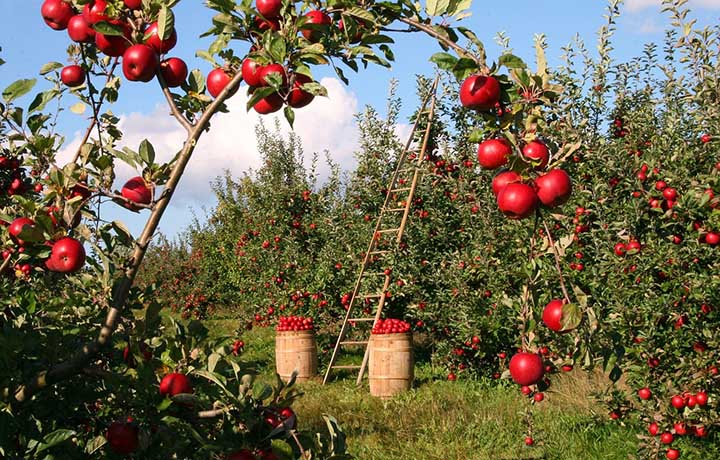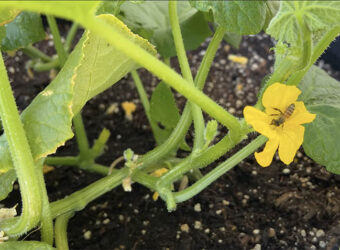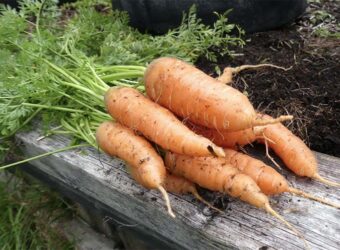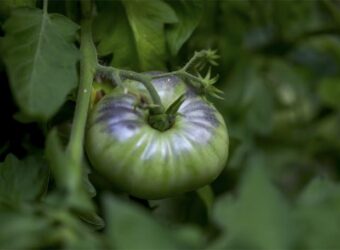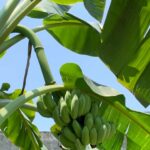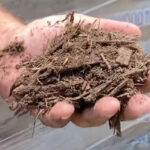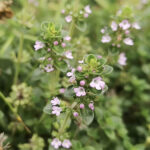Apples need to be fertilized several times during the year. Depending on your soil, you may need to add micronutrients, too. This guide will tell you how to fertilize your apple trees and the best fertilizers to use.
Here are my picks for the best apple fertilizer.
- Humboldts Secret Golden Tree is a liquid supplement to your fertilization program.
- Dr. Earth 708P Organic 9 Fruit Tree Fertilizer is my pick for the best organic fertilizer.
- Jobe’s Organics 01213, Tree Spikes, for Fruit and Nuts is the best spike for apple trees.
- Jobe’s Organics 9227 Fruit & Nut Granular Fertilizer is the best budget fertilizer.
- Espoma Organic Tree-Tone 6-3-2 Natural & Organic Fertilizer and Plant Food is my pick for the best overall fertilizer.
Why Fertilize Apples?
Apples are heavy feeders. I have found most soils do not have all the nutrients an apple tree needs. If you do not add fertilizer, the apple tree will not grow and produce apples or produce very few apples.
How Do I Know If My Apple Tree Needs Fertilizer?
If your tree is under eight years old and is growing less than twelve inches a year, it needs more nitrogen. If the leaves are yellow-tinged, it probably also needs more nitrogen. If your apples have a problem called bitter pit, they lack calcium.
What Nutrients Do Apples Need?
Growing things like apples need carbon, oxygen, and hydrogen, which they get from the soil, air, and water. In addition, they need these other nutrients.
Major Nutrients
These three nutrients are needed in large quantities by all plants, including apples. The numbers on the fertilizer bag refer to these nutrients.
Nitrogen is used throughout the plant. Apple trees with a shortage of nitrogen cannot grow or produce blooms and fruit. Too much nitrogen results in too much growth, which draws insects and is usually weak so that it will break under the wind. Excess nitrogen can also delay fruiting.
Phosphorous helps plants use the energy of the sun, grow strong roots, bloom, and set fruit. Weak roots make it hard for the tree to take up water and nutrients and anchor the tree in the soil. The shoots will be thin, and the leaves will be dark green with a reddish or purplish tint to the veins. Too much phosphorous can burn roots and leaves.
Potassium helps trees grow vigorously and healthily while resisting diseases and insects. It is necessary for good fruit size and color. A mild potassium deficiency looks similar to a nitrogen deficiency. An extreme deficiency causes the leaves to die and have scorched margins.
Minor Nutrients
Apples need these nutrients in smaller amounts, but they are still important.
Calcium makes up part of the plant walls and is a messenger element. Calcium deficiency can cause bitter pit in apples, with black spots on the apple. The flesh under the black spots is corky and not good to eat. Apples with bitter pit do not store well.
Magnesium is an essential part of chlorophyll. Without enough magnesium, the plant cannot produce enough energy to support itself.
Sulfur is used in the production of proteins, oils, chlorophyll, and other parts of the plant.
Trace Elements
Apples need these elements in trace amounts.
Iron is used to manufacture chlorophyll and is in some enzymes the apple tree needs. Lack of chlorophyll is the reason plants with an iron deficiency have yellow leaves.
Manganese is needed for some metabolic processes and helps plant growth. A lack of manganese causes young leaves to have yellow leaves with green veins. Parts of the apple tree and fruit may be contorted or stunted.
Zinc makes up enzymes that support metabolic processes in plants. Zinc deficiency can lead to stunted growth.
Copper is required for chlorophyll and seed production. It is also important in some enzymes.
Boron is important in apple trees. Apple trees use it for structural stability and to move sugar and energy through the tree. Too much boron is toxic, though.
Molybdenum regulates the conversion of nitrates into proteins. A deficiency looks like a nitrogen deficiency because the plant cannot use the nitrogen it has.
Chlorine is involved in disease resistance, using oxygen during photosynthesis, and some other plant metabolic processes.
Things to Consider When Buying Apple Fertilizers
There are a number of things to think about when buying fertilizer that goes beyond the nutrients it has. Here are some of the most important.
Soil Test
The single most important thing you can do for your apple tree is to do a soil test.
This test is sent to the soil lab in your state or area and will come back with recommendations for what your soil needs to grow the best apple trees and apples.
A soil test helps prevent over-fertilization, which can be as harmful as under-fertilization.
Apple trees are sensitive to zinc, iron, calcium, and boron deficiencies, depending on your soil type.
If you live in the United States and Canada, your extension agent can give you instructions for taking and submitting a soil sample. Elsewhere, your agricultural or horticultural adviser can help you.
Do a soil test every two to three years for existing trees and before planting a new orchard.
Buy Quality Fertilizer
Apple trees are heavy feeders and need quite a bit of fertilizer.
Don’t give in to temptation and buy cheap fertilizer. Quality fertilizers use good ingredients that are more bioavailable. They don’t get their nitrogen from sewage sludge, either.
I have found that cheap fertilizers require more fertilizer to get the same effect as quality fertilizers, so I spend about the same for inferior results.
Buy Enough
Fertilizers are usually composed of nutrients and other ingredients. If you need a pound of nitrogen for your soil, putting a pound of fertilizer out isn’t enough.
How do you figure out how much fertilizer to put out?
Here is a handy way to figure it out. If you need a pound of nitrogen, and your fertilizer is a 10-10-10, 1÷0.10=10, so you need ten pounds of 10-10-10 to put out one pound of nitrogen.
Best Fertilizers for Apples
Here are my picks for the best apple fertilizer.
1. Humboldts Secret Golden Tree – Best Liquid Fertilizer for Apple Trees

Humboldts Secret Golden Tree is a liquid supplement to your fertilization program.
It contains kelp, minerals, and carbs to help your tree use the major nutrients it needs.
The NPK ratio is 0-0-2, so you will need to add phosphorus and possibly nitrogen.
Humboldts Secret Golden Tree is a concentrate that mixes with water and can be used as a foliar spray or by pouring the liquid around the apple tree on the drip line.
How to Apply?
I would suggest using it as a foliar spray. The spray is absorbed by the leaves and starts to work immediately.
Pros:
- Improves the soil
- It can be used as a foliar spray or poured around the tree
- Encourages tree health
Cons:
- Contains no nitrogen or phosphorus
- Not organic
2. Dr. Earth 708P Organic 9 Fruit Tree Fertilizer – Best Organic Fertilizer for Apple Trees

Dr. Earth 708P Organic 9 Fruit Tree Fertilizer is my pick for the best organic fertilizer.
This fertilizer has an NPK ratio of 5-2-2. Dr. Earth includes ecto and endo mycorrhizae, probiotics, and seven strains of beneficial soil microbes to help break down the nutrients in the soil so your apple tree can use them.
Dr. Earth 708P Organic 9 Fruit Tree Fertilizer stimulates the tree to grow strong roots and abundant, nutritious fruit.
The mix of fast-release and slow-release fertilizer in this fertilizer helps apple trees grow steadily because it doesn’t cause nitrogen spikes.
The fertilizer is organic and is people and pet safe.
How to Apply?
I work Dr. Earth 708P Organic 9 Fruit Tree Fertilizer into the top two to three inches of soil and water it in. Since the fertilizer contains slow-release granules, I only have to use it a couple of times a season.
Pros:
- Organic
- Long-lasting
- It contains probiotics, soil microbes, fungi
- No fertilizer spikes that cause problem growth
Cons:
- Must be worked into the top two to three inches of soil
3. Jobe’s Organics 01213, Tree Spikes, for Fruit and Nuts – Best Spike Fertilizer for Apple Trees

Jobe’s Organics 01213, Tree Spikes, for Fruit and Nuts is the best spike for apple trees.
They are organic and long-lasting. In fact, you only use them twice a year.
Each spike contains Jobe’s patented Biozome. This is a mixture of soil microbes and fungi that help break down the nutrients in the soil so the tree can use them more fully. The nutrients are right at the root level, so fewer of them go to waste.
Because the spikes are pre-formed, I don’t have to mix anything or worry about the fertilizer running off. This is suitable for young and established apple trees.
Make sure you water the tree after hammering in the spikes and regularly throughout the growing season to prevent burning.
How to Apply?
I hammer Jobe’s Organics 01213, Tree Spikes, for Fruit and Nuts into the ground on the dripline each spring and fall.
The number of spikes I use depends on the size of the tree. I make sure to hammer the spikes far enough into the ground so they are covered with an inch or two of dirt, to keep from attracting animals to them.
Pros:
- Organic
- No mixing
- No runoff or waste
- Contains patented Biozome
Cons:
- It can attract animals if not hammered in far enough
4. Jobe’s Organics 9227 Fruit & Nut Granular Fertilizer – Best Budget Fertilizer for Apple Trees

Jobe’s Organics 9227 Fruit & Nut Granular Fertilizer is the best budget fertilizer.
The NPK ratio is 3-5-5. It also contains Jobe’s Biozome made up of soil microbes and fungi. These organisms break down the fertilizer quickly, so it is available to your apple tree.
Jobe’s Organics 9227 Fruit & Nut Granular Fertilizer is formulated to reduce stress on the tree, grow good roots, and feed the tree what it needs to make lots of apples.
It is suitable for young and established apple trees. I use this fertilizer instead of 6-10-10 because it is mild and won’t hurt my young trees.
How to Apply?
I apply three cups per inch of tree diameter with a maximum of nine cups per tree for each fertilization.
I make a circle around the tree with fertilizer on the dripline but at least thirty inches from the trunk.
I apply Jobe’s Organics 9227 Fruit & Nut Granular Fertilizer every four to six weeks. The easy-pour bag makes measuring the correct amount simple.
Pros:
- Organic
- Easy pour bag
- Fast acting
- Encourages apple tree health
Cons:
- Must reapply every 4-6 weeks during the growing season
5. Espoma Organic Tree-Tone 6-3-2 Natural & Organic Fertilizer – Best Overall Fertilizer for Apple Trees

Espoma Organic Tree-Tone 6-3-2 Natural & Organic Fertilizer and Plant Food is my pick for the best overall fertilizer.
This organic fertilizer contains Bio-tone formula, a mixture of soil microbes to improve the soil and help apple trees use the nutrients in the fertilizer better.
This fertilizer has calcium and magnesium as well as the familiar NPK. Espoma Organic Tree-Tone 6-3-2 Natural & Organic Fertilizer and Plant Food is applied twice a year, in early spring and in the fall, after the leaves drop but before the ground freezes.
Espoma is an established company with an excellent reputation and makes this fertilizer in the United States.
How to Apply?
Espoma Organic Tree-Tone 6-3-2 Natural & Organic Fertilizer and Plant Food is applied based on tree diameter.
If the tree is under six inches in diameter, I spread the fertilizer around the drip line and water the area well.
If the tree is over six inches in diameter, I dig holes every two to three feet that are three inches wide and twelve inches deep. I divide the total fertilizer between the holes, then fill in the soil and water the area.
Pros:
- Organic
- Has beneficial microbes
- Pet and people safe
- Made in the United States
Cons:
- Must bury it for large trees
Homemade versus Commercial Fertilizer
Some people prefer to make their own fertilizer rather than buy commercially prepared fertilizer. If you are one of those people, it is important to make sure your fertilizer has everything your apple trees need. For apple trees, you want twice as much nitrogen as you do phosphorus and potassium. Use the following ingredients as components.
- Nitrogen: grass clippings, leaves, coffee grounds
- Phosphorous: bonemeal, leaves
- Potassium: kelp, banana peels
Kelp, leaves, and grass clippings contain the micronutrients your apple trees will need. If they need more calcium, use ground eggshells. Crushed eggshells are not effective, so grind them to a powder.
Mixing 65 percent nitrogen with 35 percent of a mixture of phosphorus and potassium sources will fertilize your apple trees effectively. A homemade fertilizer like this will take longer to break down and become available to your apple trees, so the best time to spread it is in the fall after the apples are harvested. If you choose to use compost as fertilizer, the fall is a good time to spread it out, too.
Organic Versus Synthetic Fertilizers
Organic fertilizers are made of all-natural ingredients. In addition, to call a fertilizer organic, a manufacturer has to submit the list of ingredients as well as samples of the fertilizer to a certifying agency. That agency, typically the USDA in the United States, must verify the manufacturer’s claims for the fertilizer to be labeled organic. Natural fertilizer is not a regulated term, so you don’t necessarily get an organic fertilizer if you just purchase something labeled natural.
Dry versus Liquid Fertilizers
Dry fertilizers are solids such as granules or powders. They are generally spread around the tree and about eighteen inches to twenty-four inches from the trunk, depending on the tree’s size. Some powders and granules are mixed with water to form liquid fertilizers. Granules are often slow release. They start work in about seven days and last weeks or months. Some granules are formed into spikes that are hammered into the ground around the drip line of the apple tree.
Liquid fertilizers are often used as foliar sprays when fertilizing fruit trees. Apple trees may receive zinc, boron, and nitrogen this way, as well as mixtures of elements they need. Liquid fertilizers are taken up by the tree immediately and start working as soon as they are taken up.
When and How to Fertilize Apples?
Fertilization schedules differ depending on your climate, your soil, the fertilizer you choose, and the age of the tree. Apple and pear trees are fertilized the same, so if you have pear trees, you can follow this schedule, too. Here are some generalities I follow.
Transplants
One of the major mistakes I see people make is putting fertilizer in the hole when they plant their apple trees. In my experience, doing so will burn the roots and eventually kill the tree. Wait about three weeks after planting, then apply ½ pound 10-10-10 evenly in a circle 18-24 inches from the tree trunk. Trees are usually transplanted in the fall. Year one begins on the first of the first January after the tree is planted.
One to Three Years
Fertilizing young apple trees correctly is important to set them up for success. I suggest fertilizing once four to six weeks before bloom and again four weeks later. Divide the amounts below between the two fertilizations. If the tree has grown less than six inches the preceding year, increase the fertilizer by fifty percent. Measure the tree’s diameter one foot above the ground. Use one of these choices:
- 10-10-10 at a rate of one pound per inch of diameter, not to exceed 2 ½ pounds per tree per year.
- Or you can use calcium nitrate at a rate of 2/3 pounds per inch of trunk diameter and sulfate of potash-magnesia (sul-po-mag) at a rate of ½ pounds per inch of trunk diameter. Do not use more than 1 ¾ pounds of calcium nitrate or 1 ¼ pound of sul-po-mag per year.
- Or you can use 5-3-4 at a rate of two pounds per inch of trunk diameter. Do not exceed five pounds per year.
Fourth Year and Up
If the apple tree has not grown at least six inches the preceding year, I use the above rates. If the tree has grown at least twelve inches, I use sul-po-mag only, not 10-10-10, calcium nitrate, or 5-3-4. Fertilizing old apple trees will help them produce lots of apples. Apple trees will bear even when very old.
Boron
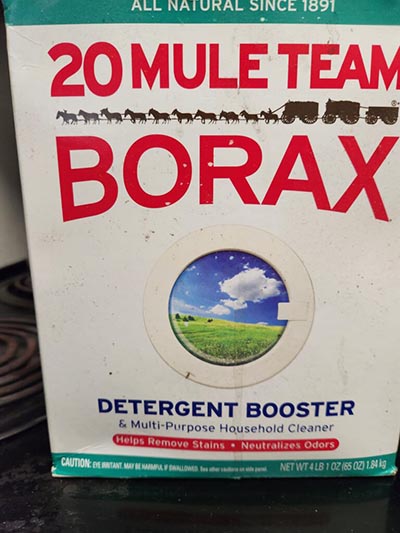
If you have a boron deficiency in your soil, you can use one to two tablespoons of 20 Mule Team Borax (in the laundry aisle) to one gallon of water and spray it on the leaves during bloom. Do not do this if the soil test shows adequate boron in the soil. Too much boron is toxic to apple trees.
Calcium
If you have a calcium deficiency in your soil, you should spray the apple tree leaves with a solution of calcium chloride and water starting after bloom and every 10-15 days through the summer. Calcium deficiencies can cause bitter pit.
Fall Micronutrient Spray
In the fall, after the apples have been harvested, I suggest spraying a micronutrient spray on the leaves of the apple tree. This sets the tree up as it forms buds for next spring.
When to Stop Fertilizing Apples?
Stop fertilizing the apple tree after the fall micronutrient spray.
Signs of Overfertilization
If the apple tree grows more than 18 inches a year, you are applying too much nitrogen. The new wood will be weak and attract insects.
Caring For Your Apples Throughout Their Lifecycle
Apple trees need more than fertilizer to thrive. Here are some tips to keep them happy.
- Choose an apple tree variety that is resistant to apple diseases in your area.
- Make sure the apple trees you choose match the chilling hours in your area. Your extension agent can tell you the chilling hours you need.
- Plant at least two apple trees so they can pollinate each other.
- Plant your trees where they get at least six hours of sunlight.
- Early morning sunlight is important to dry the dew off the leaves and prevent diseases.
- Keep an area at least twelve inches wide around the tree free of weeds and grass to give your apple tree all the water and nutrients it needs to grow and produce lots of apples.
- Water a new tree with two to three gallons of water every two to three weeks until it is a year old.
Frequently Asked Questions
Do I need to fertilize an old apple tree?
If the tree is still bearing apples, you need to fertilize it. If the tree puts on over twelve inches of new wood a year, do not use anything containing nitrogen. Use sul-po-mag only.
Is lime good for fertilizing apple trees?
Lime is not fertilizer. Lime is used to make the soil more alkaline. Apple trees like a soil pH of 6.0-6.5. If your soil pH is lower than that, you can add lime to raise it.
What is a nitrogen-rich fertilizer for apple trees?
Adding a lot of nitrogen is bad for apple trees. It causes them to grow too fast, and the succulent growth attracts insects that damage the tree. I would not use 19-19-19, 20-10-10, or 19-6-12 for apple trees to avoid these problems.
Final Verdicts
In conclusion, Espoma Organic Tree-Tone 6-3-2 Natural & Organic Fertilizer and Plant Food is my pick for the best overall fertilizer for apple trees. Espoma is an established company with an excellent reputation.
If you are looking for a budget option, try Jobe’s Organics 9227 Fruit & Nut Granular Fertilizer. For spikes, I like Jobe’s Organics 01213, Tree Spikes, for Fruit and Nuts. I think Dr. Earth 708P Organic 9 Fruit Tree Fertilizer is a good organic option, and Humboldts Secret Golden Tree is a great liquid supplement that can be sprayed on the leaves of your apple tree.
Apple trees are fertilized in the spring and fall. Because apple trees are sensitive to boron deficiency, you may need to mix some 20 Mule Team Borox with water and spray the leaves during the bloom if your soil lacks boron. Fertilizing your tree properly is the best way to ensure it has lots of tasty apples.
